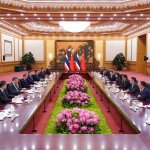
Yesterday’s clashes near Thailand’s Parliament marked a turning point for the youth-led, pro-democracy movement. More than 50 people were taken to hospital for wounds suffered during the outbreaks of violence, some with gunshot wounds. The Royal Thai Police escalated tensions early, by repeatedly firing water laced with chemicals from cannons at protesters. Members of Parliament could be seen leaving the scene early by boat.
The pro-democracy movement has been holding peaceful protests for months, calling on the government to implement a series of reforms, including the removal of Thai Prime Minister Prayut Chan-o-cha, and have called for curbs on the monarchy’s unchecked power.
However, yesterday witnessed some troubling signs–outbreaks of violence. Some protesters engaged with Yellow Shirts, pro-government counter-protesters during yesterday’s demonstration, while some resorted to spraying graffiti on walls, buildings, and on police vehicles.

These tactics are an almost inevitable sign of a protest movement first encountering resistance from counter-protesters as well as the trigger-happy hand of the state, but they should be stopped immediately because it fundamentally works against overall objectives–to mobilize additional supporters and build credibility with the Thai public.
While Thailand’s youth protests have been buoyed by support from Hong Kong, evidenced by the Milk Tea Alliance, the 2019 Hong Kong protests were an example of the dangers of uncontrolled mobilization and a lack of a commitment to non-violence by protest leaders.
It was an example of exactly what not to do.
In early 2019, Hong Kong Chief Executive Carrie Lam introduced measures that would allow extraditions to mainland China and hundreds of thousands of Hong Kong residents took to the streets. As the movement grew, it began to encounter increased resistance from the police. A lack of leadership and message control enabled more violent forms of civil disobedience when some resorted to throwing petrol bombs at police. The more the violence raged, particularly when a mob of Hong Kong protesters surrounded a man they claimed was an undercover police officer. Their justifications for violence grew. After multiple incidences of violence, including vandalizing pro-Beijing businesses, and assaulting a reporter from the Communist Party-run Global Times, people with more moderate tendencies became turned off to the movement—driven away by the violence.
This should serve as a reminder for Thai protest leaders going forward, as demonstrations have been called again and more confrontations are inevitable. The only path to undermining a regime is through non-violent means, as violence only legitimizes force by the state and creates factions within a protest movement.
The overall goal should be to create both a domestic and international backlash as well as create a space for dialogue and negotiation. Violence solves neither of those objectives. It is important for protest organizers, equipped with the power of social media and encrypted messaging applications, to send clear messages to supporters that violence should not only be discouraged, but condemned.
The message should be clear: If the government uses rubber bullets, tear gas, or water laced with chemicals, protect yourself. If you are attacked by counter-protesters, protect yourself, but don’t retaliate.






